 |
surfresearch.com.au
telegraph : swim & surf guide, 1961 |
| home | catalogue | history | references | appendix |
|
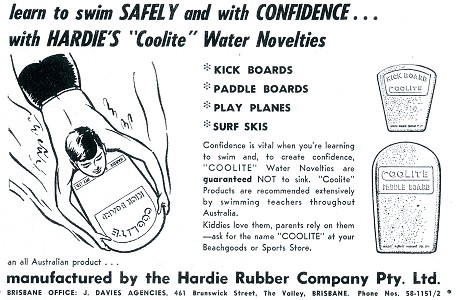
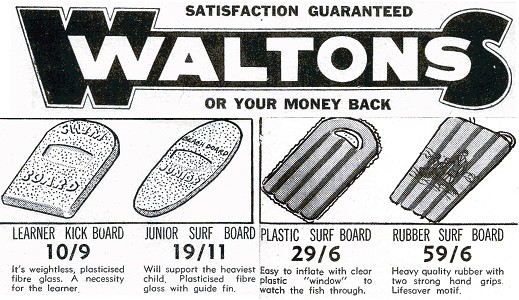
And how much more enjoyable it is for those who can ride a wave!
Mr. E. J. Smith, super-intendent of the Point Danger Branch of the Surf Life- saving Association and Valley club amateur swimming coach, has helped us to tell you how to catch that wave.
The surfer should
be positioned just beyond where the waves are breaking.
The principles
involved in catching various types of waves are divided into sections.
If the wave is
not particularly large - up to about four feet high - and breaking on a
sand bank, stand in the water about two yards from where the wave will
break.
Pick out the
wave which is rolling evenly.
Move towards
the beach and as the wave begins to break. push forward from the feet.
The body should
be held straight but not too stiffly.
The arms should
be directly in front and fully extended with the hands close together;
the head
should be down
between the arms; the toes should be pointed.
If the head is
held up, the body will tend to fall back and the wave will be missed.
As the surfer
becomes more proficient, the head can be turned to the side as in normal
swimming and a quick breath will help a t longer run on the wave.
The legs can
be used as in freestyle swimming to help keep the body in the front of
the wave and to ride the wave until it is spent.
The art of riding
a wave for a long distance can be improved by greater breath control and
better control of the legs to give body balance.
A breath can
be obtained with a swift pull under the water with the right hand through
to the right side of the body as in freestyle and with the head turning
to the right side.
The eyes should
be just clear of the water as the mouth takes in the oxygen.
The left-hand
is held fully forward for balance and the legs kicked rapidly to keep up
with the speed of the wave.
Several breaths
can be t taken in this manner.
The arms and
head actions are reversed if the breath can be taken more comfortably on
the left side.
After the first
step has been mastered and the surfer feels confident to catch a wave by
swimming on to it, another stage can be attempted.
Push off, take
one or two arm strokes to try to match the speed of the wave until the
force of the breaker can be felt and the run of the wave carries the body
forward.
The arms can
be brought to the sides while the surfer is going down the face of the
wave in what is termed "green water."
The head may
be held just above the surface with the shoulders drawn forward to help
the body gravity to be as far forward as possible.
This position
can be held until it is felt that the wave may be lost; when this happens,
the hands should be moved in to the forward position.
When these methods
have been practised sufficiently, the surfer will be ready to try deep
water.
This should be
on the high tide.
Take up a position
just beyond the breakers, choose an evenly-rolling wave and a likely-looking
swell, and swim at full speed to where the wave will break.
The swimming
action begins with a strong kick, and the overarm stroke is used to reach
the speed of the wave.
About six strokes
should be sufficient to take the surfer to a position where the wave takes
charge.
The previously-practised
method then comes into operation.
Points to remember
are:
*The speed of
the body should be approximately the same as the wave in the early stages.
*Before ceasing
to swim. the surfer must feel that the wave is taking a forward direction
towards the beach.
*Correct balance
when the body weight is concentrated forward except when riding down the
front of a steep wave.
The art of surfing
is not difficult.
It can be mastered
after practice so that the breaker can be ridden to its fullest extent.
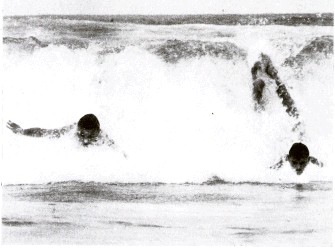 |
The Telegraph: How to Swim and Surf Guide Telegraph Newspapers, Brisbane, Queensland, 1961, page 20. |
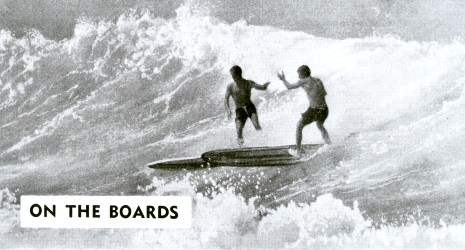 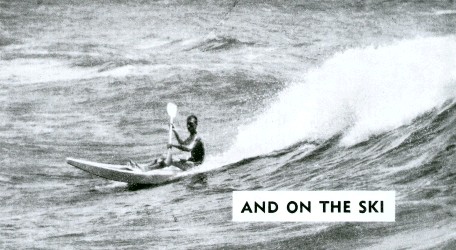 |
The new and popular
Okanui surf board, seven to 10 feet long and weighing from 20 to 30 lb.,
must be waxed before use to stop the feet slipping.
Here is some
advice for the Okanui board learner from Queensland and inter-State champion,
Ken Swan, of North Burleigh Club:
Begin in a small
or rolling surf.
The learner should
paddle out lying down, using his hands as paddles alternately.
After having
graduated from the learning stage, he can paddle out kneeling and using
both hands at the same time.
He should be positioned
slightly to the rear of the board so that more of the front of the board
than the back is out of the water.
If a large wave
should come, sit up, wrap legs and arms around the board and turn the board
over to prevent being dislodged.
The board should
be taken out about 10 to 15 yards farther than a surfer would I wait for
a wave - some 30 yards past where the waves are breaking.
The best ride
will be on a green wave.
Lie or kneel
on the board - kneeling is better because you obtain more speed.
Kneeling is a
matter of practice to get balance.
Pick a wave about
three away.
Paddle at top
speed towards the beach.
Spring to your
feet as quickly as possible when you feel the wave picking you up and shooting
you down the front.
The back foot
should be almost at right angles across the board and the front foot about
a foot away with the toes pointing ahead.
Make sure the
nose of the board is out of the water.
The board can
be turned by throwing the weight on the back foot.
Arms will help
balance.
It is like walking
along a fence.
For the surf ski, Gordon Jeffery, of Caloundra Club, four-times Queensland single ski champion, gives this advice:
Push the ski into
knee-deep water.
Sit in the middle
of the ski with the legs forward and knees slightly bent.
The feet fit
into straps.
Paddle the ski
as you would a canoe.
Begin in a small
or medium surf.
When you have
paddled far enough out, turn the ski to face the beach.
Wait for a suitable
wave and try to catch it before it breaks.
Begin paddling
when the wave is 20 to 25 feet away.
Paddle as fast
as you can.
When you feel
the ski running by itself down the front of the wave, stop paddling.
Release your
feet and slide quickly, 1ft. 6in. to 2ft., towards the back of the ski.
Balance yourself
and keep the ski straight.
Use the paddle
to straighten the ski if necessary or straighten it by leaning to the side
as you would on a bicycle.
Don't go out in
a heavy surf while learning.
When you first
pick up the wave move fast towards the rear of the ski.
The beginner
should start on the shorter ski - a 16 footer - which is wider, more stable
and easier to handle.
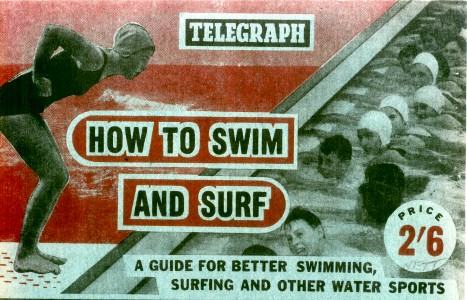 |
How to Swim and Surf Guide Brisbane, Queensland, 1961. |

| home | catalogue | history | references | appendix |